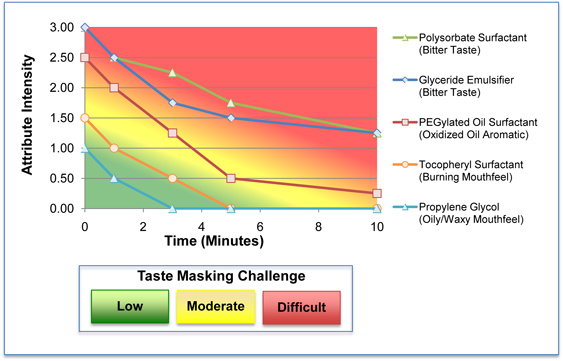Taste Masking Challenge of Solubility Enhancing Excipients
Challenge:
An estimated 80% of new drug actives are classified as poorly soluble. There are a number of approaches for enhancing solubility – alternative salt forms, particle size reduction and solubility-enhancing excipients, among others. Like APIs, many excipients are known to be bitter or have other aversive sensory attributes including aromatic off-notes (malodor) and trigeminal irritation (e.g., tongue sting and mouth/throat burn). In some cases the taste masking challenge of the excipient system can be greater than for the API itself. In order to increase the likelihood of developing a palatable drug product, the client wanted to determine the taste masking challenge of the selected solubility-enhancing excipients to help guide formulation development.
Senopsys Approach:
The client identified five excipients that improved the solubility of their API and specified minimum and maximum usage levels. As materials from different suppliers are known to differ in sensory quality, Senopsys included material from multiple manufacturers in the evaluation. The min-to-max usage level ranges were divided in thirds and extended on both the lower and upper end to provide a more robust understanding of the sensory effects as a function of strength. Samples were evaluated as aqueous solutions by Senopsys’ trained panels using the Flavor Profile method of sensory analysis.
Results
Palatable drug products are those in which the aversive sensory attributes of the API and excipient system have been minimized or eliminated. In other words they are not overly bitter, produce little trigeminal irritation, are smooth not gritty and have no perceptible malodors; known as having a “clean” sensory profile.
A slight intensity (1) on the Flavor Profile scale is the intensity at which an untrained consumer/patient can describe a perceived attribute. Therefore, to ensure palatability, the intensity of the aversive attributes should remain below a slight intensity (<1).
Shown below are the time/intensity profiles for the “cleanest” source across the five classes of solubility enhancing excipients. For each, the intensity of the most pronounced negative attribute is plotted at the material’s maximum usage level. Empirical color-coded decision boundaries are shown to facilitate interpretation.
As shown, the five classes of solubility enhancing excipients varied in terms of their sensory attributes – most notably bitter basic taste, aromatic off-notes, trigeminal irritation (burning) and mouthfeel effects (oily/waxy).
Aversive Attribute Intensity of Five Classes of Solubility Enhancers

Excipients from different suppliers are often thought to be “interchangeable.” While this may be the case for some functional properties, it is seldom the case for flavor quality.
To illustrate, the aversive sensory attributes of the same tocopherol surfactant from two suppliers are shown below. The material from Manufacturer #1 has a “cleaner” Flavor Profile with lower bitterness, mouthfeels (burning and waxy) and absence of malodor (burnt hair). Use of this material will result in a more palatable formulation than from Manufacturer #2.
Comparison of Tocopherol Surfactant Flavor Quality From Two Manufacturers

In summary, when conducting design-of-experiments for solubility enhancement, it is important to assess the sensory attributes of the individual excipients and blends in an effort to simultaneously optimize for solubility and taste.

